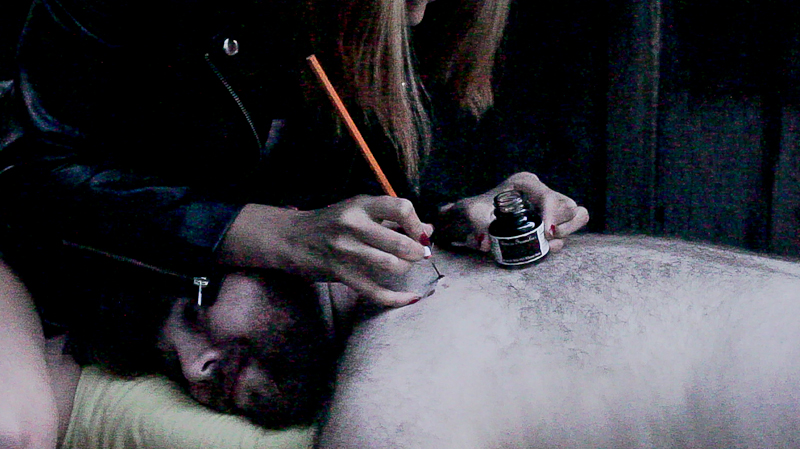Disclaimer: Creating a stick and poke tattoo is an inherently risky activity, and this blog is not a comprehensive guide on the procedure. The Charlatan does not endorse creating stick and poke tattoos at home.
It’s official: tattoos are no longer cool.
For their Fall Fashion Issue, New York Magazine featured actress Lake Bell on the cover, wearing nothing but (faux) ink in place of the latest runway garb. As a grey rose lazily climbed it’s way up Bell’s photoshopped torso, this reader couldnʼt help but yawn.
Why? Because as writer Amy Larocca discloses in her article “Ink on Ink,” tattoos have all but lost their counter-culture roots.
Larocca writes within the pages of this fashion tome:
“[Tattoos] are not subversive, they are not transgressive, they are not a mark of outsiderness. They are not for thugs or sluts, for the angry or the dispossessed. What were once the province of sailors or bikers, and then the past time of rockers and punks are now all over bank tellers and advertising executives and stay-at-home moms.”
Tattoos losing their status as fleshy markers of rebellion has been a long time coming.
It was Nov. 13, 2006 when blogger Shannon Larratt of Mod Blog, a body modification site, first introduced the world to Rick Genest, better known as Zombie Boy. While just a decade ago Genest would have been shunned for his intensely inked facade, he has instead become model and muse, lending his body to Lady Gaga, GQ Style, Vogue Hommes Japan, and Thierry Mugler among others. As of last year, you can even buy his action figure.
LA Ink, the vehicle that made the heavily branded Kat Von D a household name, started airing in 2007. Since then, Kat has gone on to use her tattoos as a tool for social and commercial ladder climbing, building an empire out of ink even your mum would approve of. No longer contained within a tattoo parlour, Kat appears in magazines, music videos, and on the shelves of Sephora and Chapters thanks to a line of cosmetics and two highly successful autobiographical books.
While perhaps seemingly innocuous, it’s crucial to remember that for our parent’s generation, facial tattoos meant biker gangs and STIs, not book deals and 15 minutes of fame.
But, as society’s view of tattoos turns from disgust to fascination to adoration, the question is asked, what are the self-identified punks and sluts of the world to do without their inky rebellion? Now that dentists and sorority girls alike are going under the needle, how does one stand out in a crowd that’s already dying to stand out? What happens when subversive culture is appropriated into mainstream culture? Where do we go from here?
Enter the world of stick and poke tattoos. Also known as prison-style tattoos, this extremely rudimentary tattooing technique can be performed by anyone with basic drawing skills and access to ink and sewing needles.
Within the past few years, stick and poke tattoos have become a more popular way of branding yourself (or your friends) due to the fact that the tattoo and the process itself is completely unique. It is not one of a handful of designs in an artist’s repertoire. It is not perfect, it is not polished. It is tied to time and place and people in a way that mainstream tattoos are not. Performed in basements and backyards, stick and pokes are forever embedded in your own personal narrative.
Giving and getting stick and pokes is a way to regain that addictive sense of defiance that made tattoos so appealing in the first place. This tattoo is entirely yours—there is an inherent guarantee that no one else will have the same wobbly lines and slightly tilted angles that make up your tattoo.
Perhaps it may seem like Iʼm tying too much sentiment to such a precarious practice. If I wax poetic, itʼs only because Iʼve had the pleasure of giving a stick and poke. It was brilliant.
The lucky recipient was one of my dear friends, Joe Ryan. Joe and I met in first year—we lived on the same dorm floor. Since then weʼve embarked on many adventures, all of which were infinitely more risky than DIY tattoos. It felt appropriate that the person to give Joe his first tattoo was someone who was anything but a stranger. Joe and I share a history—weʼve watched each other grow and change and become the people we were meant to be.
Tattooing in and of itself is penetration. Typically, all acts of penetration require a little trust. Who better to trust your body with than your best friend?
This is what makes stick and pokes truly rare and so far away from mainstream tattoos—the relationships that foster the creation of the tattoo itself. It is these same relationships that kick-started contemporary tattoo culture: underground places known through the word of mouth of friends when tattoos were still illegal. Insurgent culture is a result of strong, tight-knit communities. Stick and pokes signal a return to these communities—taking tattoos into the hands of the people, or more aptly, the friends.






